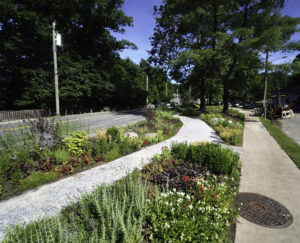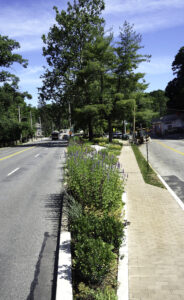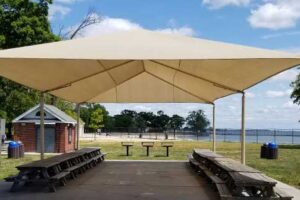
Statue Island in Sleepy Hollow is surrounded by asphalt. Four lanes of Route 9 traffic race along its western side and the vestigial Old Broadway loops to the east. Gas stations and car repair shops once gave the neighborhood the name “gasoline alley.” Until this spring, the island was little more than a patch of muddy grass. It hosted a statue of the Headless Horseman, a smattering of garbage, and a Beeline bus stop with a bench so close to the curb that riders had to dangle their legs in traffic. Now, it has been transformed by architect Margie Ruddick into an island one would want to visit.
A Sleepy Hollow resident working internationally, Ruddick designed Dutch Kills Green at Queens Plaza and the Stapleton Waterfront in Staten Island. Funded by a Local Waterfront Revitalization Grant from New York State, the redesign of Statue Island is only one piece of a larger concept. According to Lynn Moffatt, once chair of the no longer extant Sleepy Hollow Open Space Committee, Ruddick’s designs were originally intended to bring visual connectivity to several different areas throughout the village. If the concept can be fully realized, DeVries Park, Sleepy Hollow Common, and possibly Barnhardt Park would also receive Ruddick’s landscaping. At DeVries, under two additional state grants, Ruddick has so far improved a network of woodland pathways overlooking the Pocantico River and has completed tree planting to restore the degraded shoreline. The proposed 20-acre Sleepy Hollow Common on the former GM site has yet to be constructed.

At Statue Island, one is immediately struck by the great diversity of plant forms and colors. In her book Wild by Design, Ruddick expresses some frustration with the simplistic formulas of much so-called “green design.” Hence, one objective at Statue Island may have been to present as wide a spectrum of foliage as possible. There are greens in plenty, but just as many shades of burgundy and red. In the course of the month it took to write this article, one intensely yellow-green haze at knee-height (euphorbia) faded and another (alchemilla) took form closer to the ground. Indigo dots of spiderwort blinked out and waist-high candles of white penstemon appeared from deep purple stems. Then, yucca sent up even taller spires from which ivory petals lavishly drooped. Along with the seasonal flux, there is a distinct change in climate from the island’s shady northern end to its sunny southern tip, where shorter plants such as sedum and drift rose abound. Ruddick says the design “built off a palette of native plants,” comprising about 60 percent; she supplemented these with “real stalwarts” that can stand up to the island’s urban conditions. The landscaping would have included a berm, or sheltering strip of raised ground, along the edge of Route 9 but this was blocked by the New York State Department of Transportation. Now, stalks swirl in the draft off the sides of trucks.
During the planning stage, Ruddick, Moffat and the former mayor Ken Wray made several trips to Albany to sort out the jurisdictions between the state, the village, and the owner of the adjoining gas station. The state recognized the significance of Statue Island because of its location near the Old Dutch Church and along an east-west route that pedestrians can follow from Metro-North and the Riverwalk to the Old Croton Aqueduct, and from there to the North/South County Trailway. Zoning remains an obstacle to further improvement, as Sleepy Hollow village code continues to define Route 9 at Statue Island a “highway commercial” district.
Volunteers under Ruddick’s guidance will take responsibility for selective weeding, pruning, and removing trash. According to her plant list, the continually changing seasonal views by winter will yield still more discoveries. These include the evergreen inkberry, brilliant red winterberry, and Cornus sericea, “noted for its outstanding red winter stems.”






